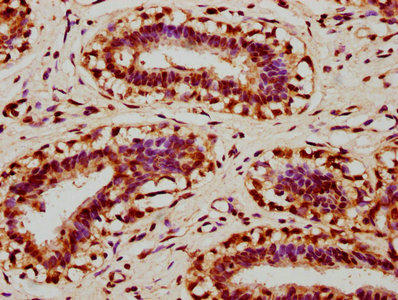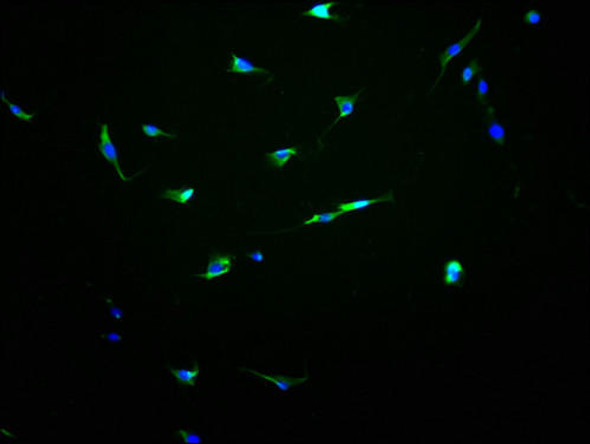Description
| Antibody Name: | UVSSA Antibody (PACO60733) |
| Antibody SKU: | PACO60733 |
| Size: | 50ug |
| Host Species: | Rabbit |
| Tested Applications: | ELISA, IHC |
| Recommended Dilutions: | ELISA:1:2000-1:10000, IHC:1:200-1:500 |
| Species Reactivity: | Human |
| Immunogen: | Recombinant Human UV-stimulated scaffold protein A protein (143-206AA) |
| Form: | Liquid |
| Storage Buffer: | Preservative: 0.03% Proclin 300 Constituents: 50% Glycerol, 0.01M PBS, pH 7.4 |
| Purification Method: | >95%, Protein G purified |
| Clonality: | Polyclonal |
| Isotype: | IgG |
| Conjugate: | Non-conjugated |
 | IHC image of PACO60733 diluted at 1:400 and staining in paraffin-embedded human breast cancer performed on a Leica BondTM system. After dewaxing and hydration, antigen retrieval was mediated by high pressure in a citrate buffer (pH 6.0). Section was blocked with 10% normal goat serum 30min at RT. Then primary antibody (1% BSA) was incubated at 4°C overnight. The primary is detected by a biotinylated secondary antibody and visualized using an HRP conjugated SP system. |
| Background: | Factor involved in transcription-coupled nucleotide excision repair (TC-NER) in response to UV damage. TC-NER allows RNA polymerase II-blocking lesions to be rapidly removed from the transcribed strand of active genes. Acts by promoting stabilization of ERCC6 by recruiting deubiquitinating enzyme USP7 to TC-NER complexes, preventing UV-induced degradation of ERCC6 by the proteasome. Interacts with the elongating form of RNA polymerase II (RNA pol IIo) and facilitates its ubiquitination at UV damage sites, leading to promote RNA pol IIo backtracking to allow access to the nucleotide excision repair machinery. Not involved in processing oxidative damage. |
| Synonyms: | UV-stimulated scaffold protein A, UVSSA, KIAA1530 |
| UniProt Protein Function: | |
| UniProt Protein Details: | |
| NCBI Summary: | The protein encoded by this gene appears to be involved in ubiquitination and dephosphorylation of RNA polymerase II subunits that stall after UV irradiation. The encoded protein interacts with several members of the nucleotide excision repair complex, and is thought to be involved in the transcription-coupled nucleotide excision repair (TC-NER) pathway to help remove lesions in the DNA that block transcription. Defects in this gene can cause UV-sensitive syndrome 3. Alternative splicing results in multiple transcript variants. [provided by RefSeq, Dec 2015] |
| UniProt Code: | Q2YD98 |
| NCBI GenInfo Identifier: | 578808194 |
| NCBI Gene ID: | 57654 |
| NCBI Accession: | XP_006713960 |
| UniProt Secondary Accession: | Q2YD98 |
| UniProt Related Accession: | Q2YD98 |
| Molecular Weight: | 77kDa |
| NCBI Full Name: | |
| NCBI Synonym Full Names: | UV stimulated scaffold protein A |
| NCBI Official Symbol: | UVSSA |
| NCBI Official Synonym Symbols: | UVSS3; KIAA1530 |
| NCBI Protein Information: | UV-stimulated scaffold protein A |
| UniProt Protein Name: | UV-stimulated scaffold protein A |
| UniProt Synonym Protein Names: | |
| Protein Family: | UV-stimulated scaffold protein |
| UniProt Gene Name: | UVSSA |
| UniProt Entry Name: | UVSSA_HUMAN |






